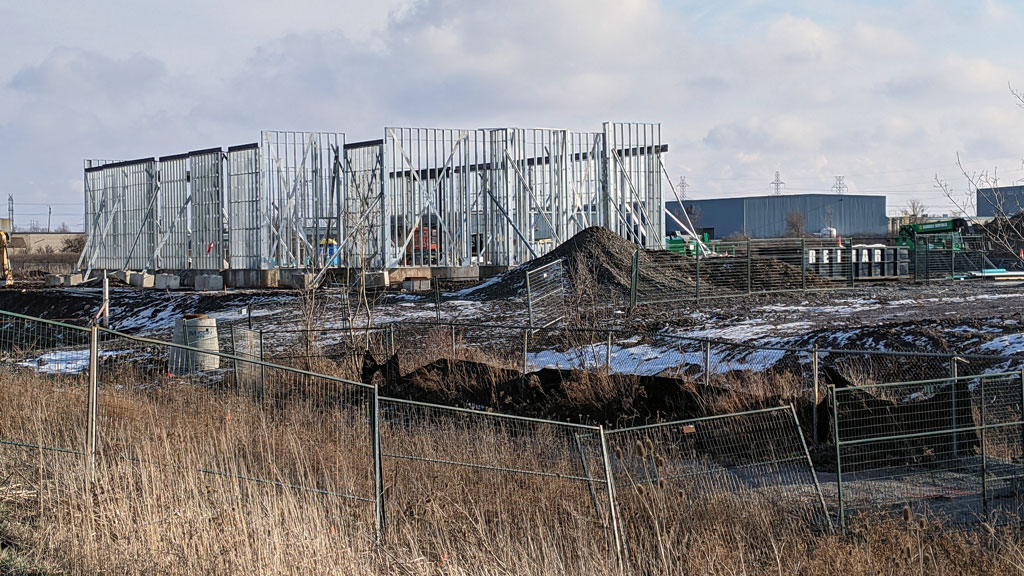Professionals in construction’s industrial sector say demand for land is sky-high, prices are at unheard-of levels and developers are hard-pressed to get projects off the ground as the sector deals with the hottest market in years.
Panellists participating in a recent webinar that focused on the sector as part of the 2021 Land and Development Conference said there is often double the number of bidders for industrial property than there was a few years back, and landlords are adopting new ways of charging for space in warehouses — it’s now sometimes by the cubic foot, not the square foot.
“It’s kind of a perfect storm,” said panellist Phil Brown, vice-president of industrial acquisitions for Hopewell Development LP.
“I think each market has unique challenges, and that mixed with the extreme demand we’re seeing has gotten us to where all of us developers are chasing every piece of land we can.”
The recent event was moderated by Nick Gaganiaras, an executive managing director with Colliers International, and the other panellists were Norm Schleehahn, the City of Hamilton’s director of economic development; Beth Berry, vice-president industrial development with Beedie; Chris Holtved, a senior portfolio manager with Healthcare of Ontario Pension Plan; and Alistair Pickering, vice-president industrial with Oxford Properties.
Gaganiaras introduced the session by observing that the industrial market in Canada was already facing a shortage of land for new developments before pandemic-induced e-commerce needs took hold. Industrial space is going through a major shift in design and development, he said, and supply chains are under new pressures.
“The chain reaction disruptions of 2020 and 2021 merely doused that fire with lighter fluid,” he said.
Land availability is a major pinch point, Brown noted, with municipal permitting departments in most of Canada’s largest cities unable to turn around serviced property at the pace developers want. Vancouver, Toronto and Montreal are problematic, he said, with Toronto beset by a long entitlement process.
Enter Hamilton, perfectly placed on the periphery of the Toronto sphere with lots of industrial land, lower prices and, importantly, Schleehahn said, a municipal government that is working hard to meet the needs of developers.
“We have to work in collaboration with developers from a municipal perspective,” he said.
“You’re seeing that collaboration with the developers to bring that supply on the street has really escalated, because the demand is certainly there, and we need to have the product online.”
The user base is diverse, Schleehahn said, with the tech sector and manufacturing showing strength in addition to the burgeoning e-commerce sector with its fulfillment centres.
“The demand has certainly skyrocketed and we don’t see that ceasing any time soon,” he said.
The search for solutions, Berry said, is causing developers to look at another source of property — infill.
“We love the infill sites, the smaller sites as well,” she said. “They’re typically faster to bring to market…there’s a lot of challenges to the larger size, just from the time-horizon perspective.”
The building products and food sectors are doing very well, Pickering said, asserting that growth in grocery deliveries may become permanent post-pandemic.
The tight market, he said, “does constrain anybody who’s looking to grow their business and maybe they have to turn business away.”
The thirst for space has landlords looking at existing spaces for underutilized cubic capacity, Pickering said. Systems consultants are working with tenants to optimize spaces and there are also labour issues as firms look for workers to perform warehouse jobs such as driving forklifts. That will spur a drive to robotics, he noted.
How tight is the market? Holtved and Gaganiaras said back in 2017 in the GTA the vacancy rate was three per cent and now it’s one per cent. Even at three per cent, Holtved said, it was a landlord’s market.
“It really impinges on economic activity because you have people who want to create facilities,” he said.
What is available is being snapped up and that will continue into next year as well, Holtved said. He has heard from the brokerage community that every building over 200,000 square feet except two has been spoken for in the GTA through 2021 and about 25 per cent of the 2022 potential deliveries have been claimed.
With so little room to manoeuvre, Holtved said, any disruption is a problem and that’s indeed the case, with delays in construction supplies causing project slowdowns. Builders are having to book flex wall six to nine months in advance.
“For the first time in my career I can honestly say we’re seeing not just one or two bids but four to five bids for available space that we have. It’s not coming until later this year,” he said. “I really don’t think it’s a healthy market economically, and collectively, between municipalities and the province, we need to figure that out.”
All this increased demand has sent land prices to new heights, Brown said, with property now costing $1 million per acre even in Whitby, Ont.
Industrial snapshot: Carrick’s view
TORONTO — ConstructConnect’s chief economist Alex Carrick offers his take on Canada’s industrial construction sector:
“Canada-wide, ConstructConnect’s dollar volume of manufacturing construction starts through May of 2021 (compared with the first five months of 2020) was up 12.1 per cent. Driven by a much higher than normal savings rate and strong pent-up demand that has accumulated during the pandemic, retail purchases will remain strong. Their continued migration online will necessitate more warehouse distribution capacity.
“Also, manufacturers’ reduced reliance on foreign suppliers as part of deglobalization implies a need for more inventory storage space at home.
“Plus, industrial starts will receive a big boost from the announced capital spending plans of the major automakers, as they pursue decarbonization through shifting production away from internal combustion engines towards electric.”
Follow the author on Twitter @DonWall_DCN.










Recent Comments
comments for this post are closed